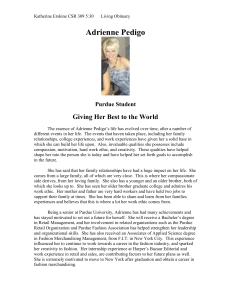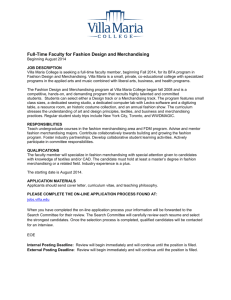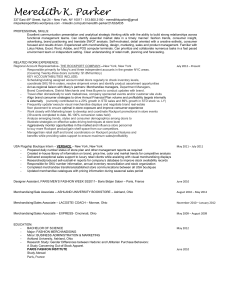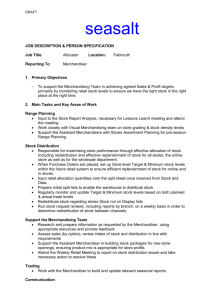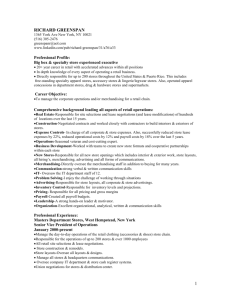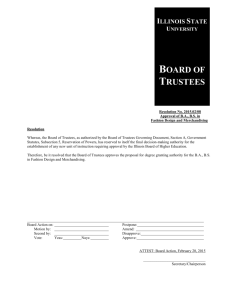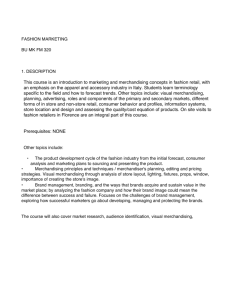ACADEMIC ASSESSMENT PLAN
advertisement
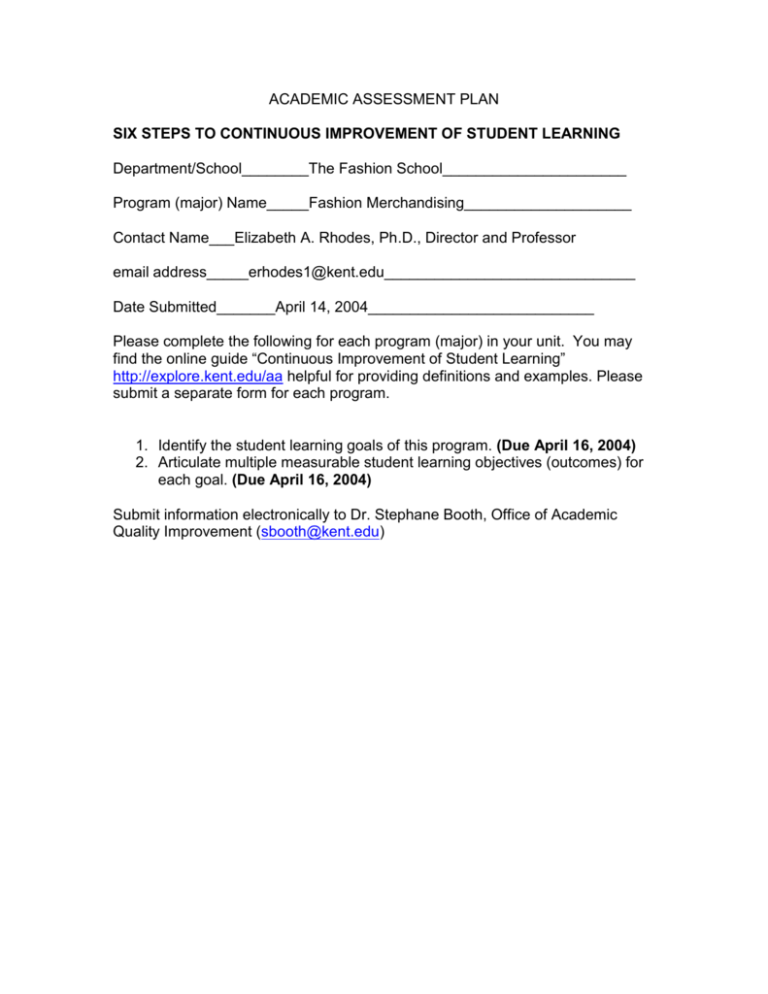
ACADEMIC ASSESSMENT PLAN SIX STEPS TO CONTINUOUS IMPROVEMENT OF STUDENT LEARNING Department/School________The Fashion School______________________ Program (major) Name_____Fashion Merchandising____________________ Contact Name___Elizabeth A. Rhodes, Ph.D., Director and Professor email address_____erhodes1@kent.edu______________________________ Date Submitted_______April 14, 2004___________________________ Please complete the following for each program (major) in your unit. You may find the online guide “Continuous Improvement of Student Learning” http://explore.kent.edu/aa helpful for providing definitions and examples. Please submit a separate form for each program. 1. Identify the student learning goals of this program. (Due April 16, 2004) 2. Articulate multiple measurable student learning objectives (outcomes) for each goal. (Due April 16, 2004) Submit information electronically to Dr. Stephane Booth, Office of Academic Quality Improvement (sbooth@kent.edu) FASHION MERCHANDISING Fashion Merchandising is the “process of moving product from producers to consumers.” The Fashion Merchandising curriculum is designed to help students develop a core set of portable skills and competencies that are relevant for the industries in which they would likely be employed. These include technical and knowledge-based, research and discovery, problem-solving, analytical, and decision-making, communication, teamwork and interpersonal skills. These skills are developed within each of the functional areas of the curriculum and are reflected in the various goals and objectives. Students who graduate with a Bachelor of Science degree in Fashion Merchandising should be competent in the areas of Retail Operations, Fashion Merchandising, Fashion Research, and Industry and Product Knowledge. These four areas are the student learning goals of the program. Student Learning Goals Operations. The goal of this part of the curriculum is to prepare students for an entrylevel position in retail operations. Many of our students launch their careers in a “management trainee” type of position with major retail organizations, such as a national or regional department store. These types of positions are usually store-based and may last approximately six months to a year in duration. From this position, the “trainee” is either promoted to a higher-level store position or a corporate position, such as in the buying office, merchandise planning, or other support function within the corporate hierarchy. The objectives outlined under the “Operations” goal are designed to prepare the student specifically for a position within a retailer’s store operations function. Having a working knowledge of how a store functions operationally is significant for our students and can give them a strategic advantage over others vying for these types of jobs. Merchandising. The goal of this part of the curriculum is to prepare students for an entry-level position in fashion merchandising. Students who are interested in careers as a retail buyer or merchandise planner/analyst can sometimes launch their careers in a “trainee” type of position with retail organizations. These types of positions are corporate-based and may last approximately six months to a year in duration. From this position, the trainee will usually be promoted to a higher-level position within their respective career paths. The objectives outlined under the “Merchandising” goal are designed to prepare the student specifically for a position within a retailer’s buying office and/or merchandise planning & allocation functions. In addition, those students who launch their careers within a retailer’s store’s organization are equally prepared for a corporate position in the buying office or merchandise planning function should their career migrate in this direction. Having a working knowledge of retail math, merchandise assortment planning, inventory sourcing, buying methods, and retail negotiation principles provides our students with a significant advantage over other applicants being considered for these types of jobs. Research. The goal of this part of the curriculum is to prepare students for an entrylevel position in fashion research and trend forecasting. Students who are interested in a career as a fashion researcher can sometimes launch their careers in a market research firm, retailer’s corporate market research function, fashion forecasting firm, and other businesses dedicated to the field of fashion research and marketing. These types of positions vary greatly between organizations and require individuals who have, for example, excellent research, analytical, writing, and presentation skills. The objectives outlined under the “Research” goal are designed to prepare the student for these types of positions. Having a working knowledge of research methodologies, sourcing secondary information, conducting primary research, evaluating and synthesizing research data, writing reports, and presenting information to the “client” provides our students with the ability to succeed in these career opportunities. Industry and Product Knowledge. The goal of this part of the curriculum is to prepare students for an entry-level position within a wide array of career opportunities within the fashion industry. Product development and private labeling of fashion apparel, marketing of apparel products, entrepreneurial ventures involving fashion apparel, and the like are examples of the types of career opportunities in which our students could be employed. In addition, application of our students’ industry and product knowledge can often be reflected in the fashion accessories, cosmetics, and home furnishings markets, in which our students are sometimes employed. The objectives outlined under the “Industry and Product Knowledge” goal are designed to prepare the student for positions within the fashion apparel industry and its allied markets. Having a working knowledge of the fashion industry and product provides our students with a significant strategic advantage over other applicants vying for comparable jobs within the fashion industry. Student Learning Objectives The following measurable objectives lead to student learning to meet the goals of competency in four areas: Retail Operations, Fashion Merchandising, Fashion Research, and Industry and Product Knowledge. Operations. At the end of this program, the students should be able to: Describe the “typical” retail stores organizational structure, position responsibilities, and chain-of-command protocol. Explain the role of store management in today’s multi-retail environments and identify the skills needed to be successful in store operations management. Read, interpret, and use “typical” retail financial data in store operations management Describe the basic principles of effective store planning and visual display standards commonly used in the retail industry. Merchandising. At the end of this program, the students should be able to: Identify and describe the roles the merchant “team” (management, merchant, planner, allocater, support staff) play in the procurement and distribution of merchandise to the multiple channels of retail outlets. Read, interpret, and use “typical” retail financial data in the execution of retail merchandising principles. Identify the competitive retail markets in which a merchant must function. Use basic retail math skills and common inventory planning methods in the daily operation of a merchandising function. Describe the inventory sourcing process and methods used to procure merchandise both domestically and internationally. Identify the factors that lead to the selection of a retail assortment. Research At the end of this program, the students should be able to: Conduct merchandising research. Locate pertinent secondary information related to fashion merchandising. Solve merchandising problems using acquired knowledge. Analyze information resulting from a merchandising research study. Evaluate, interpret, and apply information available to fashion merchandisers.to recommend a plan of action. Industry and Product Knowledge At the end of this program, the students should be able to: Identify garment styles and components, including fiber, fabric, and construction details. Describe the apparel pipeline; the progression from fiber to consumer.
